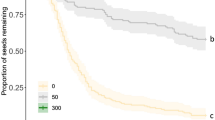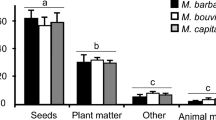Summary
The evolutionary effects of a tropical ant-seed interaction are examined by posing questions about the fate of Calathea seeds carried by neotropical ants. Where do ants take seeds and what do they do with them? How do ant behaviors affect seed germination? Treatment of seeds by ants is determined by a series of seed-fate trials in captive colonies. There is no evidence of seed predation by ants. Odontomachus laticeps, Pachycondyla spp, and Solenopsis geminata rapidly displace seeds to ant nests, determine the microsites of seeds, and remove the seed arils for food. The seed arils are rich in lipids. The effects on germination of microsite selection and aril removal are quantitatively evaluated. Seeds which are immediately taken to a consistently moist spot germinate readily; 72% germinate, with a mean germination speed of 29 days. For such seeds aril removal does not significantly affect germination. In contrast, seeds which experience a delay before encountering appropriate germination conditions seem to exhibit an induced dormancy (sensu, Harper 1977) and a lower germination percentage. They take longer to germinate (up to 85 days) even after conditions become appropriate. It appears that their germination is enhanced by aril removal, which may act as an environmental cue to break dormancy. Such a mechanism would indicate that ant-handling of seeds is predictive of favorable conditions for seedling growth and establishment. The exact nature of such conditions and the effects on plant population dynamics remain to be seen.
Similar content being viewed by others
VI. References
Augspurger CK (1979) Irregular rain cues and the germination and seedling survival of a Panamanian shrub (Hybanthus prunifolius). Oecologia (Berl) 44:53–59
Beattie AJ, Culver DC, Pudlo RJ (1979) Interactions between ants and the diaspores of some common spring flowering herbs in West Virginia. Castanea 44:177–186
Bequaert J (1922) Ants of the Museum Congo Expedition. A contribution to the myrmecology of Africa. IV. Ants in their diverse relations to the plant world. Bull Am Mus Nat Hist 45:333–358
Brown JH, Davidson DW (1977) Competition between seed-eating rodents and ants in desert ecosystems. Science 196:880–882
Colombel P (1970) Recherches sur la biologie, et l'éthologie d'Odontomachus haematodes L. (Hym. Formicoidea Poneridae). Étude des populations dans leur milieu naturel. Insectes Soc, Paris 17:183–198
Culver DC, Beattie AJ (1978) Myrmecochory in Viola: Dynamics of seed-ant interactions in some West Virginia species. J Ecol 66:53–72
Davidson DW (1977) Species diversity and community organization in desert seed-eating ants. Ecology 58:711–737
Davidson DW, Morton SR (in press) Myrmecochory in Chenopodiaceous plants of the Australian arid zone. Oecologia (Berl)
Gómez-Pompa A (1973) Ecology of the Vegetation of Veracruz. In: A Graham (ed), Vegetation and Vegetational History of Northern Latin America, pp 73–148
Gutterman Y, Witztum A, Evenari M (1967) Seed dispersal and germination in Blepharis persica (Burm) Kuntze. Israel J Bot 16:213–234
Handel S (1978) The competitive relationship of three woodland sedges and its bearing on the evolution of ant-dispersal of Carex pedunculata. Evolution 32:151–163
Harper JL, Williams TT, Sagar CR (1965) The behaviour of seeds in soil I. The heterogeneity of soil surface and its role in determining the establishment of plants from seed. J Ecol 53:273–286
Harper JL (1977) The Population Biology of Plants. Academic Press, London. UK 1977
Hartgerink AP, Bazzaz FA (1979) The influence of soil micro-heterogenities on plant reproduction under competition. Bull Ecol Soc Am 60:110
Hartshorn GS (1975) A matrix model of tree population dynamics pp 45–51. In: Golley FB, Medina E (ed), Tropical Ecological Systems: Trends in terrestrial and aquatic research. Springer Berlin Heidelberg New York
Heithaus ER, Culver DC, Beattie AJ (1980) Models of some ant-plant mutualisms. Am Nat 116:347–361
Horvitz CC (1980) Seed dispersal and seedling demography of Calathea microcephala and Calathea ovandensis, Ph D Thesis, June 1980
Horvitz CC, Beattie AJ (1980) Ant dispersal of Calathea (Marantaceae) seeds by carnivorous ponerines (Formicidae) in a tropical rain forest. Amer J Bot 67:321–326
Howe HF, Vande Kerckhove GA (1981). Removal of wild nutmeg (Virola Surinamensis) crops by birds. Ecology (in press)
Hutchison JM, Ashton FM (1979) Effect of dessication and scarification on the permeability and structure of the seed coat of Cuscuta campestris. Amer J Bot 66:40–46
Janos DP (1980) Vesicular-arbuscular mycorrhizae affect lowland tropical rain forest plant growth. Ecology 61:151–162
Janzen DH (1974) Epiphytic myrmecophytes in Sarawak: mutualism through the feeding of plants by ants. Biotropica 6:237–259
Marshall DL, Beattie AJ, Bollenbacher WE (1979) Evidence for diglycerides as attractants in an ant-seed interaction. J Chem Ecol 5:335–343
O'Dowd DJ, Hay ME (1980) Mutualism between harvester ants and a desert ephemeral: seed escape from rodents. Ecology 61:531–540
Rickson FR (1979) Absorption of animal tissue breakdown products into a plant stem: the feeding of a plant by ants. Amer J Bot 66:87–90
Roman B (1971) Tejidos vegetales. Barcelona, Paseo Bonanova 6, España
Sarukhán J, Gadgil M (1974) Studies on plant demography: Ranunculus repens L., Ramunculus bulbosus L, and Ranunculus acris L. III. A mathematical model incorporating multiple modes of reproduction. J Ecol 62:921–936
Sheldon JC (1974) The behaviour of seeds in soil III. The influence of seed morphology and the behaviour of seedlings on the establishment of plants from surface-lying seeds. J Ecol 62:47–66
Smith MR (1936) The ants of Puerto Rico. J Agr Univ Puerto Rico 20:819–875
Soto-E M (1976) Algunos aspectos climáticos de la región de Los Tuxtlas. In: A Gómez-Pompa et al (eds), Regeneración de Selvas, Compañia Editorial Continental SA México
Ule E (1905) Wechselbeziehungen zwischen Ameisen und Pflanzen. Flora 94:491–497
Ule E (1908) Die Pflanzenformationen des Amazonas-Gebietes. II. Pflanzengeographische Ergebnisse meiner in den Jahren 1900–1903 in Brasilien und Peru unternommenen Reisen. Engl Bot Jahrb XL 4:398–443
van der Pijl L (1951) On the morphology of some tropical plants, Gloriosa, Bougainvillea, Honckneya, Rottboelia. Phytomorphology 1:185–188
van der Pijl L (1955) Some remarks on myrmecophytes. Phytomorphology 5:190–200
van der Pijl L (1971) Principles of Dispersal in Higher Plants, Springer, Berlin Heidelberg New York
Wilson EO (1971) The Insect Societies. The Belknap Press of Harvard University Press, Cambridge, Mass
Author information
Authors and Affiliations
Rights and permissions
About this article
Cite this article
Horvitz, C.C. Analysis of how ant behaviors affect germination in a tropical myrmecochore Calathea microcephala (P. & E.) Koernicke (Marantaceae): Microsite selection and aril removal by neotropical ants, Odontomachus, Pachycondyla, and Solenopsis (Formicidae). Oecologia 51, 47–52 (1981). https://doi.org/10.1007/BF00344651
Received:
Issue Date:
DOI: https://doi.org/10.1007/BF00344651




